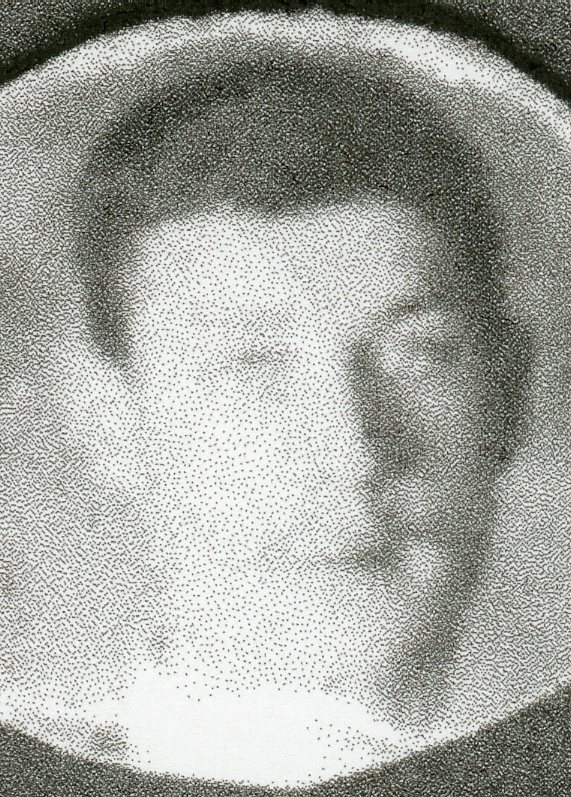Rfn
William Albert Fisk
Informations sur naissance
|
Année de naissance: 1890 |
|
Lieu de naissance: Leyton, Essex, Angleterre, Royaume-Uni |
Informations générales
|
Profession: Carter avec cheval et chariot |
Informations service militaire
|
Pays: Angleterre, Royaume-Uni |
|
Force armée: British Expeditionary Force |
|
Rang: Rifleman |
|
Numéro de service: A/201475 |
|
Incorporation nom de lieu: Leytonstone, Essex, Angleterre, Royaume-Uni |
|
Unités: — King's Royal Rifle Corps, 9th Bn. (Dernière unité connue) |
Informations sur décès
|
Date de décès: 22/10/1917 |
|
Lieu de décès: Polderhoek, Belgique |
|
Cause du décès: Killed in action (K.I.A.) |
|
Âge: 27 |
Mémorial
|
Tyne Cot Memorial Panneau: 117A |
Distinctions et médailles 2
|
British War Medal Médaille — 05/03/1920 |
|
Victory Medal Médaille — 05/03/1920 |
Points d'intérêt 3
| #1 | Lieu de naissance | ||
| #2 | Lieu d'enrôlement | ||
| #3 | Lieu du décès (approximatif) |
Mon histoire
Rifleman William Albert Fisk served in the King's Royal Rifle Corps 9th Battalion, part of the 42nd Brigade, of the 14th (Light) Division. The Division participated in the Third Battle of Ypres and the 9th King’s Royal Rifle Corps moved to Flanders in September 1917. It was first stationed in the Messines sector, which was fairly quiet compared to the sectors further north, where the offensive raged.
On the 16th of October the Battalion moved up to the frontline at the hamlet of Polderhoek, where it relieved the 7th Rifle Brigade. The conditions at this part of the front were appalling. The constant shelling had honeycombed the terrain with waterlogged shellholes. Artillery fire had also destroyed the banks of the local irrigation canals. So when it rained the water had no way out, inundating the low-lying areas. The Battalion’s support area had been transformed in a miniature lake, making the deliveries of messages and supplies an arduous task. On top of these difficult circumstances the 9th King’s Royal Rifle Corps faced the German defences at Polderhoek Château. Polderhoek Château was situated on a hill overlooking the wider area. It’s ruins had been transformed into a stronghold, from where the Germans directed their artillery. Consequently the Battalion was frequently subjected shelling, causing heavy casualties. Each German barrage was followed by a British barrage. But many British guns had been worn out by the constant shooting and lacked precision. Therefore many shells fell short and came crashing down on the Battalion’s positions.
During the morning of 22 October 1917 there was considerable German shelling. Around midday the British heavy artillery retaliated and put down a barrage on Polderhoek Château. A large number of rounds fell near the Battalion’s headquarters and into the support lines, where several men were constructing new trenches. The consequences were severe and the battalion suffered a total of 71 casualties. Rifleman William Albert Fisk was possibly one of them, as he was killed in action on the 22nd of October 1917. William Albert Fisk has no known grave and is remembered on the Tyne Cot Memorial.
The Battalion was eventually relieved from the frontline on the 24th of October 1917. During their eight-day tour at the front the Battalion suffered a total of 148 casualties. Two officers and 43 other ranks were killed in action. Six more died of their wounds, while two officers and 84 men were wounded. Eleven more men were gassed.
On the 16th of October the Battalion moved up to the frontline at the hamlet of Polderhoek, where it relieved the 7th Rifle Brigade. The conditions at this part of the front were appalling. The constant shelling had honeycombed the terrain with waterlogged shellholes. Artillery fire had also destroyed the banks of the local irrigation canals. So when it rained the water had no way out, inundating the low-lying areas. The Battalion’s support area had been transformed in a miniature lake, making the deliveries of messages and supplies an arduous task. On top of these difficult circumstances the 9th King’s Royal Rifle Corps faced the German defences at Polderhoek Château. Polderhoek Château was situated on a hill overlooking the wider area. It’s ruins had been transformed into a stronghold, from where the Germans directed their artillery. Consequently the Battalion was frequently subjected shelling, causing heavy casualties. Each German barrage was followed by a British barrage. But many British guns had been worn out by the constant shooting and lacked precision. Therefore many shells fell short and came crashing down on the Battalion’s positions.
During the morning of 22 October 1917 there was considerable German shelling. Around midday the British heavy artillery retaliated and put down a barrage on Polderhoek Château. A large number of rounds fell near the Battalion’s headquarters and into the support lines, where several men were constructing new trenches. The consequences were severe and the battalion suffered a total of 71 casualties. Rifleman William Albert Fisk was possibly one of them, as he was killed in action on the 22nd of October 1917. William Albert Fisk has no known grave and is remembered on the Tyne Cot Memorial.
The Battalion was eventually relieved from the frontline on the 24th of October 1917. During their eight-day tour at the front the Battalion suffered a total of 148 casualties. Two officers and 43 other ranks were killed in action. Six more died of their wounds, while two officers and 84 men were wounded. Eleven more men were gassed.
Sources 2
|
9 Battalion King's Royal Rifle Corps , (The National Archives, KEW (TNA), WO 95/1900/2). https://discovery.nationalarchives.gov.uk/details/r/C14303 Autre référence |
|
Byron R., The King's Royal Rifle Corps Chronicle: 1917, (London, John Murray, 1920), pg. 119-121. Sources utilisées |
Complément d’informations 3
|
Commonwealth War Graves Commission Database https://www.cwgc.org/find-records/find-war-dead/casualty-details/1631975 |
|
Namenlijst (In Flanders Fields Museum) https://namenlijst.org/publicsearch/#/person/_id=14302e34-f720-4c78-9e03-79dd2e42b9ee |
|
Lives of the First World War (Imperial War Museum) https://livesofthefirstworldwar.iwm.org.uk/lifestory/2471868 |
